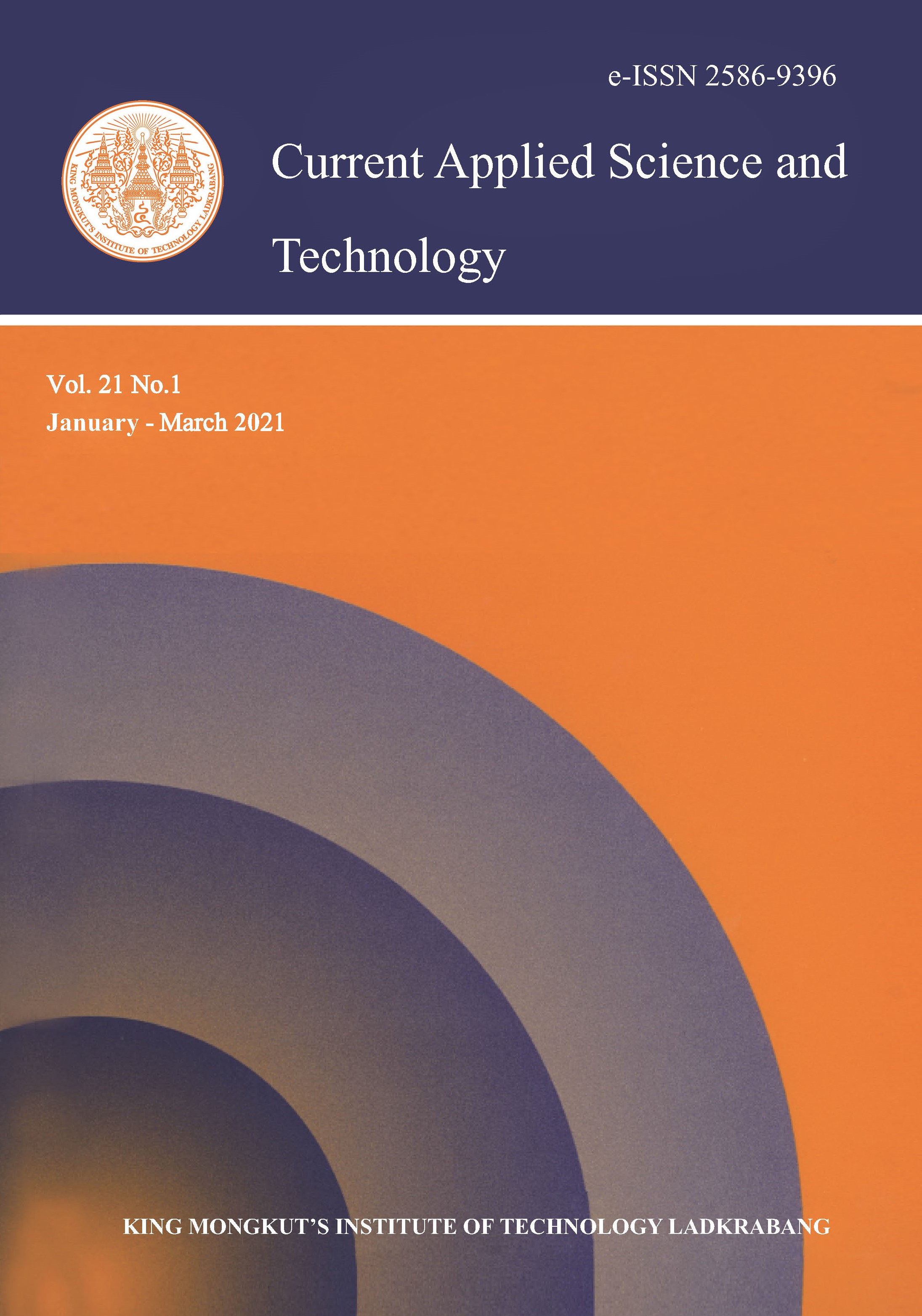Adsorption of Dye Over Lignin Obtained from Wastewater Separation
Main Article Content
Abstract
Lignin is a major by-product problem for the pulp and paper industry. In our previous work, lignin was successfully separated from alkali lignin wastewater using iron (III) trimesic (Fe-BTC). This separation resulted in three layers: supernatant, lignin sludge, and Fe-BTC powder. In this study, the lignin separated by Fe-BTC (LSF) was expected to be used as an adsorbent for reactive red-120 dye (RR-120) removal. The LSF morphology was characterized by scanning electron microscope and energy dispersive X-ray spectrometer (SEM-EDS), the specific surface area was analyzed by Brunauer-Emmett-Teller (BET) method, and the functional groups were investigated by Fourier transform infrared (FTIR) spectrometer. The removal performance of LSF over RR-120 was approximately 35% in 60 min. The maximum adsorption capacity of LSF for RR-120 was found to be 10.363 mg/g. The adsorption kinetic of RR-120 removal fitted well with the pseudo-second-order kinetic model. The adsorption isotherm model of LSF also fitted with the Langmuir isotherm model. This research suggests the high potential of LSF as a lignin-based adsorbent agent for RR-120 removal in water.
Keywords: adsorption; dye; iron (III) trimesic; lignin; reactive red-120
*Corresponding author: Tel.: +664-336-2140 Fax: +664-320-2571
E-mail: visanu@kku.ac.th
Article Details
Copyright Transfer Statement
The copyright of this article is transferred to Current Applied Science and Technology journal with effect if and when the article is accepted for publication. The copyright transfer covers the exclusive right to reproduce and distribute the article, including reprints, translations, photographic reproductions, electronic form (offline, online) or any other reproductions of similar nature.
The author warrants that this contribution is original and that he/she has full power to make this grant. The author signs for and accepts responsibility for releasing this material on behalf of any and all co-authors.
Here is the link for download: Copyright transfer form.pdf
References
Bazrafshan, E., Ahmadabadi, M. and Mahvi, A.H., 2013. Reactive red-120 removal by activated carbon obtained from cumin herb wastes. Fresenius Environmental Bulletin, 22(2A), 584-590.
Hossein, M.A. and Behzad, H., 2012. Removal of reactive red 120 and direct red 81 dyes from aqueous solutions by Pumice. Research Journal of Chemistry and Environment, 16(1), 62-68.
Amran, M., Salleh, M., Khalid, D., Azlina, W., Abdul, W. and Idris, A., 2011. Cationic and anionic dye adsorption by agricultural solid wastes: A comprehensive review. Desalination, 280, 1-13.
Leah, M.F., Love, M., Angela, D., Ruffel, R., Paoprasert, P. and Daniel, M., 2018. Adsorption of methylene blue dye and Cu (II) ions on EDTA-modified bentonite: Isotherm, kinetic and thermodynamic studies. Sustainable Environment Research, 28(5), 1-9.
Kaykhaii, M., Sasani, M. and Marghzari, S., 2018. Removal of dyes from the environment by adsorption process. Chemical and Materials Engineering, 6(2), 31-35.
Suteu, D., Malutan, T. and Bilba, D., 2010. Removal of reactive dye Brilliant Red HE-3B from aqueous solutions by industrial lignin: Equilibrium and kinetics modelling. Desalination, 255(1-3), 84-90.
Pangkumhang, B., Jutaporn, P., Sorachoti, K., Khamdahsag, P. and Tanboonchuy, V., 2019. Applicability of iron (III) trimesic (Fe-BTC) to enhance lignin separation from pulp and paper wastewater. Sains Malaysiana, 48(1), 199-208.
Feizi, Z.H. and Fatehi, P., 2018.Production of flocculants, adsorbents, and dispersants from lignin. Molecules, 23, 868-893.
Tesfaw, B., Chekol, F., Mehretie, S. and Admassie, S., 2016. Adsorption of Pb ( II ) ions from aqueous solution using lignin from Hagenia abyssinica. Bulletin of the Chemical Society of Ethiopia, 30(3), 473-484.
Xu, T., Zhang, N., Nichols, H.L., Shi, D. and Wen, X., 2007. Modification of nanostructured materials for biomedical applications. Materials Science and Engineering: C, 27(3), 579-594.
Kajjumba, G.W., Emik, S., Özcan, A., Özcan, H.K. and Öngen, A., 2018. Modelling of adsorption kinetic processes-errors, theory and application. Intech, 1, 13, https://doi.org.10.5772/intechopen.80495
Ali, I.H., Mesfer, M.K.A., Khan, M.I., Danish, M. and Alghamdi, M.M., 2019. Exploring adsorption process of lead (II) and chromium (VI) ions from aqueous solutions on acid activated carbon prepared from Juniperus procera leaves. Processes, 7(4), 217, https://doi.org/10.3390/pr7040217
Kanna, R.R., Lenin, N., Sakthipandi, K. and Kumar, A.S., 2018. Structural, optical, dielectric and magnetic studies of gadolinium-added Mn-Cu nanoferrites. Journal of Magnetism and Magnetic Materials, 453, 78-90.
Kerolli-Mustafa, M., Bačic̈, I. and Ćurkovic̈, L., 2013. Investigation of jarosite process tailing waste by means of raman and infrared spectroscopy. Materialwissenschaft und Werkstofftechnik, 44(9), 768-773.
Li, Z., Xiao, D., Ge, Y. and Koehler, S., 2015. Surface-functionalized porous lignin for fast and efficient lead removal from aqueous solution. Applied Materials & Interfaces, 7(27), 15000-15009.
Ge, Y., Qin, L. and Li, Z., 2016. Lignin microspheres: An effective and recyclable natural polymer-based adsorbent for lead ion removal. Materials and Design, 95, 141-147.


